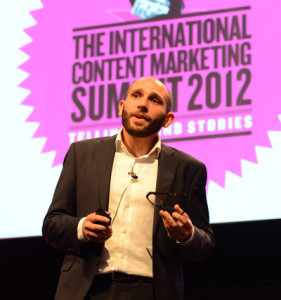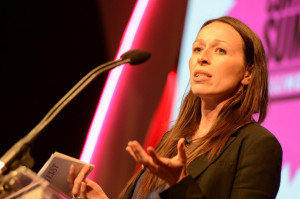The after lunch session at the International Content Marketing Summit drilled down into the business of the storytelling and engaging creative.
 The first panel of speakers which included Nick Morris, Founder and Strategy Director, Canvas8, Sara Cremer, Managing Director, Redwood and Claire Hilton, Head of Advertising, Media and Content, UKRBB Marketing, Barclays and James Keady, Digital Marketing Manager at McLaren Automotive, unpicked the crucial elements of a good story.
The first panel of speakers which included Nick Morris, Founder and Strategy Director, Canvas8, Sara Cremer, Managing Director, Redwood and Claire Hilton, Head of Advertising, Media and Content, UKRBB Marketing, Barclays and James Keady, Digital Marketing Manager at McLaren Automotive, unpicked the crucial elements of a good story.
1. Capture versus build
We’re used to receiving information immediately. When and where we want it. We’re becoming more demanding for the reward, and this impatience is impacting many industries including storytelling and this explains why Bond did better than Tinker, Tailor, Soldier, Spy at the box office. One took over an hour to build the other explodes on to the screen. The audience got instant gratification and this is turning story telling on its head.
2. Remember that stories are for the benefit of the listener, not the storyteller.
People remember stories they don’t remember a series of facts, which as in the case of Barclays, when you have a series dry product information you need to identify the link between what the brand is selling and what the customer is thinking. Consequently you need to know what your customers are really thinking, not what you hope they are thinking, or what you want them to think.
3. Emotion= action
Tapping into customers emotions will ultimately tie customers more closely to the brand. Barclay’s personalised Visa debit card initiative which enables customers to have their photos, doodles and pictures printed onto their payment card is a good example of this.
4. Intrigue.
The greatest stories are those that are half told, leaving you wanting more.
 A panel session with Marie O’Riordan, Editorial Director at John Brown, Steve Watson at The Church of London, Lisa Smosarski, Editor of Stylist and Marcus Webb, Co-director, The Slow Journalism Company and Editor of Delayed Gratification discussed the vital role that creative plays in ensuring that content does it job.
A panel session with Marie O’Riordan, Editorial Director at John Brown, Steve Watson at The Church of London, Lisa Smosarski, Editor of Stylist and Marcus Webb, Co-director, The Slow Journalism Company and Editor of Delayed Gratification discussed the vital role that creative plays in ensuring that content does it job.
Using examples from Marie Claire, Stylist, More Magazine and Little White Lies and Delayed Gratification we examined initiatives that turned the norm on its head. From handing over an entire issue of Stylist over to its readers to putting a man on the cover of woman’s mag or the overriding message was to think differently. Not to be scared of the bold – on the proviso that it is relevant to the audience. Different is disruptive, but if it misses the mark, creativity fails. Key to this is finding your niche. Niche does not need to mean small. It means not to be average. It is no longer survival of the fittest but survival of the best fit.
 Finally, key note speaker Matthew Taylor, CEO, Royal Society of Arts summed up the Summit with a witty and a provocative speech challenging content to inspire change, charging the audience to create consumerly content that leaves the customer better informed and more able to make wise decisions, truly demonstrating the power of content
Finally, key note speaker Matthew Taylor, CEO, Royal Society of Arts summed up the Summit with a witty and a provocative speech challenging content to inspire change, charging the audience to create consumerly content that leaves the customer better informed and more able to make wise decisions, truly demonstrating the power of content






